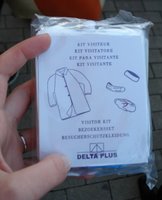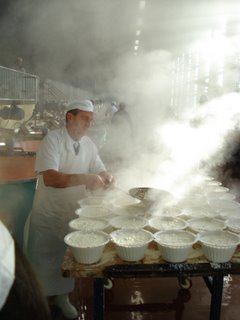The king of cheese
Playing catch up again. Below is a post I meant to make before the new year. More soon!*************
 Not that our campus isn't impressive, but when all of Italia beckons just outside the classroom door, who wouldn't squirm in her seat just a little?
Not that our campus isn't impressive, but when all of Italia beckons just outside the classroom door, who wouldn't squirm in her seat just a little?I think every student of the UNISG class of 2007 was excited for our first stage. We'd been studying the chemical process of cheese for days. Now we were ready to go straight to the source. Over two days, we saw the entire process: from cows on the farm to a well-aged round that started its transformation more than three years ago.
 The stage went a little backwards because of a transportation strike (always full of surprises, this bell'Italia), but we rearranged the trip and saw cheesemaking first and the cows second. At the caseificio we donned our "visitor packs" and marched not at all inconspicuously, despite our milky costumes. Liters and liters of milk were pumped into huge copper-lined cauldrons while the cheesemakers carefully monitored the rising temperature, adding the starters and rennet at just the right time and wielding the tools of the trade like extensions of their own limbs. One huge cauldron would yield 2 rounds of parmigiano reggianno to be pressed and molded, salt-washed, stamped, and aged."
The stage went a little backwards because of a transportation strike (always full of surprises, this bell'Italia), but we rearranged the trip and saw cheesemaking first and the cows second. At the caseificio we donned our "visitor packs" and marched not at all inconspicuously, despite our milky costumes. Liters and liters of milk were pumped into huge copper-lined cauldrons while the cheesemakers carefully monitored the rising temperature, adding the starters and rennet at just the right time and wielding the tools of the trade like extensions of their own limbs. One huge cauldron would yield 2 rounds of parmigiano reggianno to be pressed and molded, salt-washed, stamped, and aged."
Before leaving, I asked the youngest-looking cheesemaker how long he'd been making the king of cheeses. "Thirteen years. That's my dad," he said pointing toward the oldest-looking cheesemaker of the bunch. "So we have all been doing this for a long time. Brothers, brothers-in-law, my mom works in the shop."
"How often do you eat parmigiano reggiano?" I asked. "Not very often," he responded, smiling, "But Dad eats it every day. Kilos and kilos. I don't know how he does it."

Talk about being tied to your work...Usually parmigiano makers live next door to the caseficio since they have to make their cheese every day that the cows give milk (aka every single day). Usually the house is paid for by the collection of farmers who bring their milk to the casseficio. In the old days, especially talented cheesemakers were given expensive tips like jewelry and cars. But watching Emanuele's dad shovel twice-cooked whey (ie ricotta, a byproduct of parmigiano-making) through the steam of a hot cauldron into sopping, seeping colanders, I had a feeling he wasn't in it for the money.
After a lunch of splendid olive oil, pinzimonio, and no less than 4 types of parmigiano reggiano, we met with a representative from the parmigiano reggiano consortium. Ironically, there are about as many parmigiano producers as there are Hoosier museums. The consortium has a longer history than the Association of Indiana Museums, though. It's been marketing and advocating for parmiggiano reggiano since 1934.
Their representative was full of facts and futures. About 83% of the 3.1 million rounds of parm produced last year was sold in Italia. But the consortium is facing challenges. For at least the last two years, the average cost to produce the cheese has been higher than its average purchase price. The number of producers is decreasing, and in 2007, the national government plans to end its subsidies to producers who let their cheese age longer than the minimum age required before the cheese can be sold.
The next day we had a quick meeting with the president of the Parma provence at the Municipal Building in Parma. He and his vice president welcomed us, confirmed their belief in the importance of our field of study, and took a group photo that later appeared in one of Parma's newspapers. While shaking hands, I asked his favorite gelato flavor. He laughed, leaned in a little and said, "Pistacchio."
The recipe for the week? I feel a bit like I'm cheating because pinzimonio doesn't really involve any cooking, but since it was a featured dish during our stage lunch and since it goes so well with a nice chuck of well-aged parm, enjoy!
Pinzimonio
Slice up tasty fresh vegetables as you like. You might try carrots, beet root, fennel, tender artichoke leaves, anything you like raw. Pour peppery, green olive oil into a bowl for dipping and serve with the raw veg.
Yup, that's it. That's the whole recipe. The hinge of the dish, though, is the oil. You might look for an extra virgin olive oil from Sicily like the excellent one we ate during our stage lunch.


3 Comments:
Sounds like you are working hard but having fun up there! I just want to know when we are going to meet up? Any free days? Jackie, are you interested too?
Cyn
If you like Parmigiano...then you must try the king of the "grana" from Trento, "la grana trentina". My son came home for Christmas from Trento and brought three types of incredible cheese from the Christmas market, one with a purple skin from being soaked in a local red wine!
Thanks Elizabeth -- sounds delicious!
-Corrie
Post a Comment
<< Home